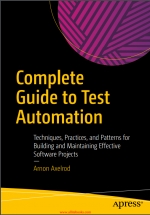Complete Guide to Test Automation. A. Axelrod

Категория: C#
Поделиться:
There are many great books about test automation, and particularly about best practices of Test Automation. However, there’s no one size fits all. As I once heard someone saying: “‘Best Practices’ is always contextual: even something as common as breathing may be catastrophic if the context is free diving…” Most of the books that I have read so far about test automation are aimed mainly for developers, focusing mainly at unit tests or at developer-written end-to-end tests. Some other books that I either read or know about deal with a specific test automation technology, methodology, or are simply just too outdated. While I tend to agree that the idea of developers writing the tests may be very effective in many situations, in reality it doesn’t fit all organizations at all stages. Moreover, test automation is a tool that serves and affects nearly all stakeholders of a software development organization, including testers, product managers, software architects, DevOps people, and the managers of the projects, and not only developers. As every software organization and project is different, trying to adopt techniques, practices, and tools that don’t fit the team’s needs or skills can cause the failure of the automation project and in some cases even the failure of the entire software project.The goal of this book is to give a broad view on the subject of test automation in order to allow the reader to make smart decisions upon his particular case, giving his constraints and the benefits he wants to gain from having the test automation, but also to provide detailed and hands-on guidance for building it effectively, at least for the majority of cases.
Скачать
Комментарии